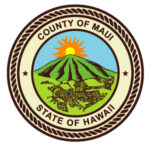Pu‘u ‘Ula‘ula is the highest point on Haleakala’s summit, with an elevation of 10,023 feet. But the mountain was once much higher than this.
At one time Maui consisted of 2 separate islands. The sea between them was filled with erosion from the two Volcanoes, and the fertile Central Maui valley was formed connecting the West and South. Factors that have contributed to Haleakala’s shrinking include thousands of years of wind and water erosion that began to carve two large river valleys out of the rim, rapid caldera collapse, and slow sinking into the ocean bed. The volcanoes of the Hawaiian chain do not erupt violently like Mt St. Helens, but rather have a long, sustained and relatively gentle eruptive cycle. They form “shield” volcanoes, so-called because they resemble the silhouette of an ancient Greek shield. As with icebergs, these volcanoes show only a small part of their total mass above water, leaving 95% below on an ocean seamount. Haleakala is the 3rd highest point in the Hawaiian islands. It is also the third highest mountain in the world from seamount to top.
As the Pacific plate moves northwestward at 10 cm per year, it carries the shield-stage volcano away from its heat source. As a result, the volcano erupts less frequently, and the lava erupted will differ chemically from that produced during the shield stage because of the diminished heat supply. These changes define the character of the third stage, called postshield volcanism. Nearly 200 km from the hot spot, Haleakala volcano is still in its postshield stage of volcanic evolution, and has been active for two million years. It remains active, having erupted several times in the past 1,000 years.
Haleakala’s last eruption was near the southernmost foot of the mountain at La Perouse Bay in the mid-1700s. Postshield lava supply is diminished, but not curtailed completely.
Haleakala will erupt again, given the frequency of its past eruptions and long eruptive history. Modern under- standing is that the recent, and coming eruptions are the waning efforts of a postshield-stage volcano.
Question of the Week:
Have you visited Haleakala National Park?
Leave a comment here or post it on the Focus Maui Nui Facebook Page. Mahalo!

